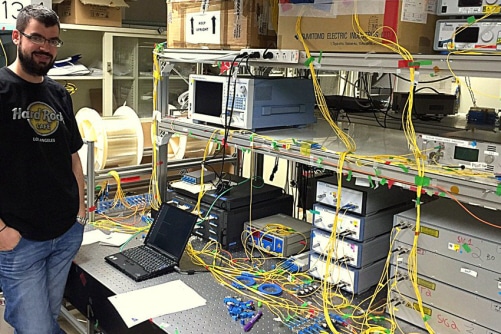Sep 15 2016
In the face of increasing bandwidth demands, ground-breaking research between the University of Bristol and the National Institute of Information and Communication Technology (NICT) in Japan, has demonstrated solutions for network infrastructure to address the looming network capacity crunch.
 George Saridis in the NICT lab. (Credit: University of Bristol)
George Saridis in the NICT lab. (Credit: University of Bristol)
The joint work between the University’s High Performance Networks Group (HPN), and NICT’s Photonic Network System Laboratory, has investigated the role of space division multiplexing (SDM) technologies to unlock the full potential of optical networking. The research will be presented at the leading European optical communications conference, ECOC 2016, next week [18-22 September].
With the soaring traffic demands of nearly a trillion online Internet of Things (IoT) devices and bandwidth hungry emerging applications, like ultra-high-definition (UHD) and 8K video streaming, cloud storage and processing, the need to increase network capacity is becoming critical.
To address this need, University of Bristol and NICT have worked together to exploit and demonstrate the potential of new types of multicore optical fibres to deliver higher capacity and flexibility in future optical networks.
George Saridis, PhD student and researcher in the HPN Group, said: “By combining state-of-the-art technology and SDM knowledge from NICT together with Bristol’s long experience in optical networking, we were able to conduct ground-breaking research accompanied by numerous network experiments.”
Optical fibre networks and communication systems, mainly based on standard single mode fibre (SSMF) links, currently support most of the intensive global data communication needs.
Cutting-edge optical multicore fibres (MCFs) and similar types of SDM technologies can offer an opportunity to scale up the interconnection capacity, in modern optical networks. By using the space dimension, as well as frequency and time, the academics solutions have the ability to combine multiple streams of frequency/time multiplexed data in the same fibre structure, by either using different cores or/and light modes.
MCFs, comprised of tens of heterogeneous cores, are able to exhibit links of unprecedented capacity, in the range of multiple petabits per second (1 Pbit/sec = 1,000,000 Gbit/sec). There are potentially tremendous network capabilities in the exascale region, the success of which depends on the physical variations of MCFs characteristics and behaviour. SDMs tools and features are to be fully exploited in metro, core and data centre networks.
Dr Naoya Wada, Director General of Network System Research Institute, and Head of the Photonics Network System Laboratory at NICT, commented: “NICT performs research into ultra-high capacity multicore fibre transmission technologies and optical integrated network technologies to meet the increased demand for data services, which are predicted to increase exponentially by 2020. The University of Bristol is the leading research field on flexible network systems and this collaboration will open a new era of ultra-high capacity, fully dynamic, fully flexible optical network systems.”
Professor Dimitra Simeonidou, Head of the High Performance Networks Group and Director of the Smart Internet Lab at the University of Bristol, added: “Our research collaboration with NICT in Japan has been long-standing and very productive. Over the years we have worked together to demonstrate a number of ground-breaking optical networking technologies that have been published in high impact journals. Our latest work could change the way that future communication systems will deliver capacity and services.”